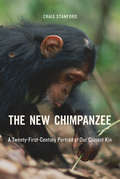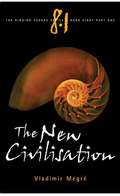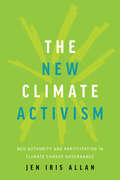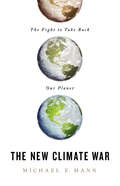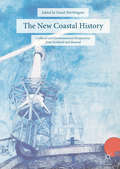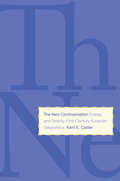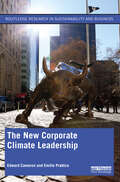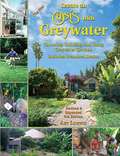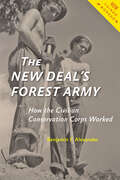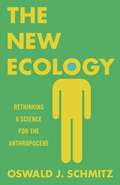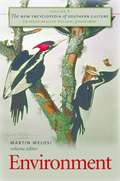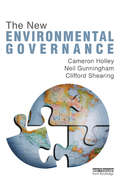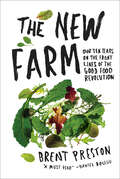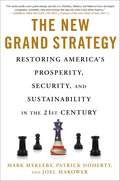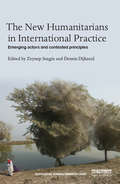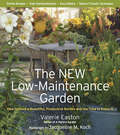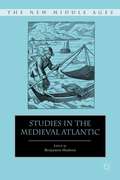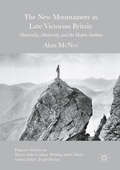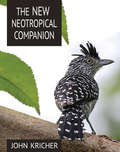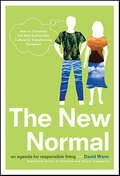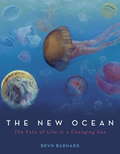- Table View
- List View
The New B.C. Roadside Naturalist
by Richard Cannings Sydney CanningsIn this fascinating guide to the roadside ecology of the major highways in B.C., you'll discover a whole new dimension to taking a car trip. This new edition has been updated and expanded to cover northern British Columbia and southern Yukon, giving readers a unique perspective on the northern wildlife and vegetation. Southern travellers "may find that this journey will redefine what 'northern British Columbia' means to them, or even what 'north' means."Sidebars tell stories about various species, such as the huge, endangered sturgeon and the Great Basin spadefoot toad, which spends most of the year underground. Full-colour photographs and black-and-white drawings illustrate numerous plants and animals that make their homes along the roadsides of British Columbia, and maps show the route of each highway discussed. In addition, the book offers suggestions for where to stop and look for crayfish, enjoy a swim in summer, or have a picnic lunch during your travels. An appendix provides a brief field guide of tree silhouettes and hints for identifying trees and shrubs.Whether you're taking a day trip or a two-week holiday, your drive along the highways of B.C. will be enriched by the storehouse of information in this facinating and informative guide.
The New Chimpanzee: A Twenty-First-Century Portrait of Our Closest Kin
by Craig StanfordRecent discoveries about wild chimpanzees have dramatically reshaped our understanding of these great apes and their kinship with humans. We now know that chimpanzees not only have genomes similar to our own but also plot political coups, wage wars over territory, pass on cultural traditions to younger generations, and ruthlessly strategize for resources, including sexual partners. In The New Chimpanzee, Craig Stanford challenges us to let apes guide our inquiry into what it means to be human. With wit and lucidity, Stanford explains what the past two decades of chimpanzee field research has taught us about the origins of human social behavior, the nature of aggression and communication, and the divergence of humans and apes from a common ancestor. Drawing on his extensive observations of chimpanzee behavior and social dynamics, Stanford adds to our knowledge of chimpanzees’ political intelligence, sexual power plays, violent ambition, cultural diversity, and adaptability. The New Chimpanzee portrays a complex and even more humanlike ape than the one Jane Goodall popularized more than a half century ago. It also sounds an urgent call for the protection of our nearest relatives at a moment when their survival is at risk.
The New Civilisation (The Ringing Cedars Series #8, Part #1)
by Vladimir Megré John Woodsworth Leonid Sharashkin"The New Civilisation" is Book 8 Part 1 of The Ringing Cedars Book Series. This series of nine books tells the story of a remarkable woman named Anastasia, discovered in 1995 by a Siberian trader, Vladimir Megré, while he was plying the waters of the remote Ob River. Anastasia was born in the forest in 1969 to parents who died tragically when she was just a baby. Living for the most part without warm clothes, food cultivation or man-made shelter, she has survived on fruit, nuts, berries and mushrooms, brought to her by "wild" animals with which she lives in peaceful harmony. Megré initially spent three days with Anastasia, during which time she displayed such astounding knowledge, power and wisdom that he abandoned his business and, at her request, began writing this series. She told him she would encode the books with an energy that would cause them to sell in the millions. Despite his lack of writing experience, this is exactly what happened. It is Anastasia's ability to strike a chord in the heart of the reader that makes these books so very unusual. The purity and power of her words is provoking an outpouring of joy and hope in people from all walks of life.
The New Climate Activism: NGO Authority and Participation in Climate Change Governance
by Jen AllanAt the 2019 UN climate change conference, activists and delegates for groups representing Indigenous, youth, women, and labour rights were among those marching through the halls chanting "Climate Justice, People Power." In The New Climate Activism, Jen Iris Allan looks at why and how these social activists came to participate in climate change governance while others, such as those working on human rights and health, remain on the outside of climate activism. Through case studies of women’s rights, labour, alter-globalization, health, and human rights activism, Allan shows that some activists sought and successfully gained recognition as part of climate change governance, while others remained marginalized. While concepts key to some social activists, including gender mainstreaming, just transition, and climate justice are common terms, human rights and health remain "fringe issues" in climate change governance. The New Climate Activism explores why and how these activists brought their issues to climate change, and why some succeeded while others did not.
The New Climate War: The Fight to Take Back Our Planet
by Michael E. MannA renowned climate scientist shows how fossil fuel companies have waged a thirty-year campaign to deflect blame and responsibility and delay action on climate change, and offers a battle plan for how we can save the planet. Recycle. Fly less. Eat less meat. These are some of the ways that we've been told can slow climate change. But the inordinate emphasis on individual behavior is the result of a marketing campaign that has succeeded in placing the responsibility for fixing climate change squarely on the shoulders of individuals.Fossil fuel companies have followed the example of other industries deflecting blame (think "guns don't kill people, people kill people") or greenwashing (think of the beverage industry's "Crying Indian" commercials of the 1970s). Meanwhile, they've blocked efforts to regulate or price carbon emissions, run PR campaigns aimed at discrediting viable alternatives, and have abdicated their responsibility in fixing the problem they've created. The result has been disastrous for our planet.In The New Climate War, Mann argues that all is not lost. He draws the battle lines between the people and the polluters-fossil fuel companies, right-wing plutocrats, and petrostates. And he outlines a plan for forcing our governments and corporations to wake up and make real change, including:a common-sense, attainable approach to carbon pricing- and a revision of the well-intentioned but flawed currently proposed version of the Green New Deal;allowing renewable energy to compete fairly against fossil fuelsdebunking the false narratives and arguments that have worked their way into the climate debate and driven a wedge between even those who support climate change solutionscombatting climate doomism and despair-mongering With immensely powerful vested interests aligned in defense of the fossil fuel status quo, the societal tipping point won't happen without the active participation of citizens everywhere aiding in the collective push forward. This book will reach, inform, and enable citizens everywhere to join this battle for our planet.
The New Coastal History
by David WorthingtonThis book provides a pathway for the New Coastal History. Our littorals are all too often the setting for climate change and the political, refugee and migration crises that blight our age. Yet historians have continued, in large part, to ignore the space between the sea and the land. Through a range of conceptual and thematic chapters, this book remedies that. Scotland, a country where one is never more than fifty miles from saltwater, provides a platform as regards the majority of chapters, in accounting for and supporting the clusters of scholarship that have begun to gather around the coast. The book presents a new approach that is distinct from both terrestrial and maritime history, and which helps bring environmental history to the shore. Its cross-disciplinary perspectives will be of appeal to scholars and students in those fields, as well as in the environmental humanities, coastal archaeology, human geography and anthropology.
The New Consumers: The Influence Of Affluence On The Environment
by Jennifer Kent Norman MyersWhile overconsumption by the developed world's roughly one billion inhabitants is an abiding problem, another one billion increasingly affluent "new consumers" in developing countries will place additional strains on the earth's resources, argue authors Norman Myers and Jennifer Kent in this important new book. The New Consumers examines the environmental impacts of this increased consumption, with particular focus on two commodities -- cars and meat -- that stand to have the most far-reaching effects. It analyzes consumption patterns in a number of different countries, with special emphasis on China and India (whose surging economies, as well as their large populations, are likely to account for exceptional growth in humanity's ecological footprint), and surveys big-picture issues such as the globalization of economies, consumer goods, and lifestyles. Ultimately, according to the orman Myers and Jennifer Kent, the challenge will be for all of humanity to transition to sustainable levels of consumption, for it is unrealistic to expect "new" consumers not to aspire to be like the "old" ones. Cogent in its analysis, The New Consumers issues a timely warning of a major and developing environmental trend, and suggests valuable strategies for ameliorating its effects.
The New Continentalism
by Kent E. CalderIn this groundbreaking book Kent E. Calder argues that a new transnational configuration is emerging in Asia, driven by economic growth, rising energy demand, and the erosion of longstanding geopolitical divisions. What Calder calls the New Silk Road—with a strengthening multi-faceted relationship between East Asia and the Middle East at its core—could eventually emerge as one of the world’s most important multilateral configurations. Straddling the border between comparative politics and international relations theory, this important book will stimulate debate and discussion in both fields.
The New Corporate Climate Leadership (Routledge Research in Sustainability and Business)
by Edward Cameron Emilie PratticoThis book provides a comprehensive treatment of the role of the private sector in accelerating the transition to a low-carbon, climate-resilient, and inclusive world. In the lead up to and since the historic Paris Agreement on climate change, more than 6,000 companies from 120 countries representing more than $36.5 trillion in revenue have made climate commitments. Examining this trend, The New Corporate Climate Leadership provides a clear synthesis of the relationship between the real economy and climate change and offers a state-of-the-art assessment of corporate initiatives that focus on greenhouse gas emissions reductions and the management of climate risk through enhanced resilience. It debates the relative merits of incremental and sequenced ambition versus radical systems change – including a critique of the prevailing capitalist approach to climate change – and provides an actionable guide to skills development for change-makers in the shift toward a low-carbon world. Drawing on perspectives from leading thinkers inside the private sector, across government, and within civil society to truly interrogate the scale, scope, and speed of progress, this book provides a clear vision for what the next generation of corporate climate leadership should look like. Optimistic in tone, this book will be of great interest to students, scholars, and practitioners of climate change and sustainable business.
The New Create an Oasis With Greywater:Choosing, Building, and Using Greywater Systems (5th Edition)
by Art LudwigThis book describes how to choose, build, and use 20 types of residential greywater reuse systems in just about any context: urban, rural, or village.
The New Deal's Forest Army: How the Civilian Conservation Corps Worked (How Things Worked)
by Benjamin F. AlexanderHow the Civilian Conservation Corps constructed, rejuvenated, and protected American forests and parks at the height of the Great Depression.Propelled by the unprecedented poverty of the Great Depression, President Franklin D. Roosevelt established an array of massive public works programs designed to provide direct relief to America’s poor and unemployed. The New Deal’s most tangible legacy may be the Civilian Conservation Corps’s network of parks, national forests, scenic roadways, and picnic shelters that still mark the country’s landscape. CCC enrollees, most of them unmarried young men, lived in camps run by the Army and worked hard for wages (most of which they had to send home to their families) to preserve America’s natural treasures. In The New Deal’s Forest Army, Benjamin F. Alexander chronicles how the corps came about, the process applicants went through to get in, and what jobs they actually did. He also explains how the camps and the work sites were run, how enrollees spent their leisure time, and how World War II brought the CCC to its end. Connecting the story of the CCC with the Roosevelt administration’s larger initiatives, Alexander describes how FDR’s policies constituted a mixed blessing for African Americans who, even while singled out for harsh treatment, benefited enough from the New Deal to become an increasingly strong part of the electorate behind the Democratic Party. The CCC was the only large-scale employment program whose existence FDR foreshadowed in speeches during the 1932 campaign—and the dearest to his heart throughout the decade that it lasted. Alexander reveals how the work itself left a lasting imprint on the country’s terrain as the enrollees planted trees, fought forest fires, landscaped public parks, restored historic battlegrounds, and constructed dams and terraces to prevent floods. A uniquely detailed exploration of life in the CCC, The New Deal’s Forest Army compellingly demonstrates how one New Deal program changed America and gave birth to both contemporary forestry and the modern environmental movement.
The New Ecology: Rethinking a Science for the Anthropocene
by Oswald J. SchmitzHow the science of ecology is changing to meet the daunting challenges of environmental sustainabilityOur species has transitioned from being one among millions on Earth to the species that is single-handedly transforming the entire planet to suit its own needs. In order to meet the daunting challenges of environmental sustainability in this epoch of human domination—known as the Anthropocene—ecologists have begun to think differently about the interdependencies between humans and the natural world. This concise and accessible book provides the best available introduction to what this new ecology is all about—and why it matters more than ever before.Oswald Schmitz describes how the science of ecology is evolving to provide a better understanding of how human agency is shaping the natural world, often in never-before-seen ways. The new ecology emphasizes the importance of conserving species diversity, because it can offer a portfolio of options to keep our ecosystems resilient in the face of environmental change. It envisions humans taking on new roles as thoughtful stewards of the environment to ensure that ecosystems have the enduring capacity to supply the environmental services on which our economic well-being—and our very existence—depend. It offers the ecological know-how to maintain and enhance our planet's environmental performance and ecosystem production for the benefit of current and future generations.Informative and engaging, The New Ecology shows how today’s ecology can provide the insights we need to appreciate the crucial role we play in this era of unprecedented global environmental transition.
The New Economy of Nature
by Gretchen C. Daily Catherine EllisonHow to use the environment profitably.
The New Encyclopedia of Southern Culture: Environment
by Martin MelosiFrom semitropical coastal areas to high mountain terrain, from swampy lowlands to modern cities, the environment holds a fundamental importance in shaping the character of the American South. This volume of The New Encyclopedia of Southern Culture surveys the dynamic environmental forces that have shaped human culture in the region--and the ways humans have shaped their environment. Articles examine how the South's ecology, physiography, and climate have influenced southerners--not only as a daily fact of life but also as a metaphor for understanding culture and identity. This volume includes ninety-eight essays that explore--both broadly and specifically--elements of the southern environment. Thematic overviews address subjects such as plants, animals, energy use and development, and natural disasters. Shorter topical entries feature familiar species such as the alligator, the ivory-billed woodpecker, kudzu, and the mockingbird. Also covered are important individuals in southern environmental history and prominent places in the landscape, such as the South's national parks and seashores. New articles cover contemporary issues in land use and conservation, environmental protection, and the current status of the flora and fauna widely associated with the South.
The New Entrants Problem in International Fisheries Law
by Andrew SerdyAre international fisheries heading away from open access to a global commons towards a regime of property rights? The distributional implications of denying access to newcomers and re-entrants that used the resource in the past are fraught. Should the winners in this process compensate the losers and, if so, how? Regional Fisheries Management Organisations, in whose gift participatory rights increasingly lie, are perceptibly shifting their attention to this approach, which has hitherto been little analysed; this book provides a review of the practice of these bodies and the States that are their members. The recently favoured response of governments, combating 'IUU' - illegal, unregulated and unreported - fishing, is shown to rest on a flawed concept, and the solution might lie less in law than in legal policy: compulsory dispute settlement to moderate their claims and an expansion of the possibilities of trading of quotas to make solving the global overcapacity issue easier.
The New Environmental Governance
by Clifford Shearing Cameron Holley Neil GunninghamA bold and profoundly new way of governing environmental problems is palpable around the globe and aims to overcome the limitations of the interventionist state and its market alternative to offer more effective and legitimate solutions to today's most pressing environmental problems. The 'new environmental governance' (NEG) emphasises a host of novel characteristics including participation, collaboration, deliberation, learning and adaptation and 'new' forms of accountability. While these unique features have generated significant praise from legal and governance scholars, there have been very few systematic evaluations of NEG in practice, and it is still unclear whether NEG will in fact 'work', and if so, when and how. This book offers one of the most rigorous research investigations into cutting edge trends in environmental governance to date. Focusing its inquiry around some of the most central, controversial and/or under researched characteristics of NEG, the book offers fresh insights into the conditions under which we can best achieve successful collaboration, effective learning and adaptation, meaningful participatory and deliberative governance and effective forms of accountability. The book synthesizes its findings to identify seven key pillars of 'good' NEG that are central to its success and will provide useful guidance for policymakers and scholars seeking to apply new governance to a wide range of environmental and non-environmental policy contexts. The book also advances our understanding of State governance and will be a valuable reference for scholars, researchers and students working in law and regulation studies - especially in the field of environmental law.
The New Farm: Our Ten Years on the Front Lines of the Good Food Revolution
by Brent PrestonThis “must-read” memoir of human-scale agriculture offers an insider’s view of today’s food system by a leading voice in sustainable farming (Daniel Boulud). After years of working at the ends of the earth in human rights and development, Brent Preston and his wife were die-hard city dwellers. But when their second child arrived, the shine came off urban living. In 2003 they bought a hundred acres and a rundown farmhouse, determined to build a farm that would sustain their family, nourish their community, heal their environment—and turn a profit. The New Farm is Preston’s memoir of a decade of toil and perseverance. Farming is a complex and precarious business, and they made plenty of mistakes along the way. But as they learned how to grow food, and to succeed at the business of farming, they also found that a small, sustainable, organic farm could be an engine for change, a path to a more just and sustainable food system. Today, The New Farm supplies top restaurants, supports community food banks, hosts events with leading chefs, and grows extraordinary produce. Told with humor and heart, The New Farm is a joy, a passionate book by an important new voice.
The New Grand Strategy: Restoring America's Prosperity, Security, and Sustainability in the 21st Century
by Joel Makower Patrick Doherty Mark MyklebyThe New Grand Strategy tells the story of a plan, born within the Pentagon, to recapture America’s greatness at home and abroad by elevating sustainability as our new strategic imperative. It aligns our enduring national interests of prosperity and security with a new framework that addresses pressing economic, social, and environmental issues at home, tapping into a trillion-dollar market demand for walkable communities, regenerative agriculture and resource productivity. It is an inspiring vision of what’s possible when Americans hold a collective view of the future and come together to bring it to reality.This is no idealistic pipe dream or wonky policy prescription. The story that unfolds in this book weaves together hard-nosed economic analysis, a clear-eyed study of demographic and societal shifts, the realities of climate change and resource scarcity, a risk-based assessment of America’s challenges and opportunities, and on-the-ground reporting of how much this is already unfolding throughout the country. By rediscovering the power and discipline of grand strategy—and taking responsibility for our future—America can reimagine the American dream and once again take on “the cause of all mankind.”Released during one of America’s most divisive presidential election campaigns, The New Grand Strategy avoids the partisan rhetoric dividing our nation today. Instead of placing blame, it offers a clear, pragmatic plan that can unite Americans and launch a new era of prosperity and security.
The New Humanitarians in International Practice: Emerging actors and contested principles (Routledge Humanitarian Studies)
by Dennis Dijkzeul Zeynep SezginAs humanitarian needs continue to grow rapidly, humanitarian action has become more contested, with new actors entering the field to address unmet needs, but also challenging long-held principles and precepts. This volume provides detailed empirical comparisons between emerging and traditional humanitarian actors. It sheds light on why and how the emerging actors engage in humanitarian crises and how their activities are carried out and perceived in their transnational organizational environment. It develops and applies a conceptual framework that fosters research on humanitarian actors and the humanitarian principles. In particular, it simultaneously refers to theories of organizational sociology and international relations to identify both the structural and the situational factors that influence the motivations, aims and activities of these actors, and their different levels of commitment to the traditional humanitarian principles. It thus elucidates the role of the humanitarian principles in promoting coherence and coordination in the crowded and diverse world of humanitarian action, and discusses whether alternative principles and parallel humanitarian systems are in the making. This volume will be of great interest to postgraduate students and scholars in humanitarian studies, globalization and transnationalism research, organizational sociology, international relations, development studies, and migration and diaspora studies, as well as policy makers and practitioners engaged in humanitarian action, development cooperation and migration issues.
The New Low-Maintenance Garden: How to Have a Beautiful, Productive Garden and the Time to Enjoy It
by Valerie Easton Jacqueline Knox Jacqueline M. KochDo you ever lament that you'd love to be able to garden more, but just don't have the time? The demanding pace of modern life leaves little space for the pleasures of gardening. On the other hand, gardening itself could be the culprit: elaborate, traditional perennial borders; water-hungry or disease-prone plants; needy lawns; and high-maintenance plants that require staking or clipping all suck up precious hours. Simply put, we need to start gardening in a whole new way. In this inspiring book, Val Easton shows exactly how to have a low-maintenance garden that doesn't sacrifice style. You won't have to give up your favorite plants or settle for expanses of ugly bark nuggets. You just have to unlearn some bad old habits and pick up some good new ones. So, how do you go about making a "new" low-maintenance garden? First, design your garden with maintenance in mind—good-looking hardscape will both save weeding time and showcase your favorite plants. Second, simplify your garden routines—learn the most efficient planting and maintenance techniques and don't get stressed if everything isn't letter-perfect. Third, learn how to work with nature rather than against it. And finally, embrace home-grown fruits, herbs, and vegetables; well planted containers; and thoughtfully chosen plants.The New Low-Maintenance Garden doesn't just tell you how to garden in a whole new way—it shows you, through profiles and beautiful photographs of real gardens that embody low-maintenance techniques. The pressures of life are not likely to ease up anytime soon, but the lessons of this timely book will help you banish guilt over undone garden chores and revel in your garden successes.
The New Middle Ages
by Benjamin HudsonThis collection of essays offers fresh analysis of topics in the exciting area of Atlantic World studies. Challenging standard assumptions, the essays advance the argument that the Atlantic Ocean was a region that encompassed ethnic and political boundaries, in which a sub-community shaped by culture and commerce arose.
The New Mountaineer in Late Victorian Britain
by Alan McneeThis book is about the rise of a new ethos in British mountaineering during the late nineteenth century. It traces how British attitudes to mountains were transformed by developments both within the new sport of mountaineering and in the wider fin-de-siècle culture. The emergence of the new genre of mountaineering literature, which helped to create a self-conscious community of climbers with broadly shared values, coincided with a range of cultural and scientific trends that also influenced the direction of mountaineering. The author discusses the growing preoccupation with the physical basis of aesthetic sensations, and with physicality and materiality in general; the new interest in the physiology of effort and fatigue; and the characteristically Victorian drive to enumerate, codify, and classify. Examining a wide range of texts, from memoirs and climbing club journals to hotel visitors' books, he argues that the figure known as the 'New Mountaineer' was seen to embody a distinctly modern approach to mountain climbing and mountain aesthetics.
The New Neotropical Companion
by John KricherThe New Neotropical Companion is the completely revised and expanded edition of a book that has helped thousands of people to understand the complex ecology and natural history of the most species-rich area on Earth, the American tropics. Featuring stunning color photos throughout, it is a sweeping and cutting-edge account of tropical ecology that includes not only tropical rain forests but also other ecosystems such as cloud forests, rivers, savannas, and mountains. This is the only guide to the American tropics that is all-inclusive, encompassing the entire region's ecology and the amazing relationships among species rather than focusing just on species identification.The New Neotropical Companion is a book unlike any other. Here, you will learn how to recognize distinctive ecological patterns of rain forests and other habitats and to interpret how these remarkable ecosystems function—everything is explained in clear and engaging prose free of jargon. You will also be introduced to the region's astonishing plant and animal life.Informative and entertaining, The New Neotropical Companion is a pleasurable escape for armchair naturalists, and visitors to the American tropics will want to refer to this book before, during, and after their trip.Covers all of tropical AmericaDescribes the species and habitats most likely to be observed by visitorsIncludes every major ecosystem, from lowland rain forests to the high AndesFeatures a wealth of color photos of habitats, plants, and animals
The New Normal: An Agenda for Responsible Living
by David WannIn Simple Prosperity, Dave Wann showed readers how to have an abundant, sustainable life. In The New Normal, he challenges us to do some heavy lifting and transform our non-sustainable culture by transforming ourselves. For Wann, our current "old normal" lifestyle - buying water in disposable bottles, allowing the government to ignore global warming - will not preserve the planet. To nurture our world, he challenges us to rethink our lives, stand up for a healthy planet and move towards a "new normal" lifestyle in an agenda that includes:- Initiating local business alliances that actively lobby for local buying.- Creating an investment strategy that values the balance of nature.- Supporting the design, manufacture, and use of products made with natural chemicals.- Publicly advocating a more efficient use of water by placing a higher cultural value on wetlands, streams, rivers, and lakes.The New Normal is Dave Wann's way forward, a blueprint for a better life that preserves our world.
The New Ocean: The Fate of Life in a Changing Sea
by Bryn BarnardA fascinating look at the future of our oceans—and how human actions may change them. The Earth—our home—is covered mostly with water: the wide, deep, salty, and very blue ocean. It regulates our climate in a way that makes life as we know it possible. This huge ocean is full of an amazing amount of life, most of which is too small to see. But life in the ocean is in trouble. The ocean is becoming hotter, more polluted, and, in places, empty of life. The right amount of warming is good for us, but too much warming is causing shifts that are not good for life in the ocean. Global warming, pollution, and overfishing are creating a New Ocean, in which life is changing drastically. This book tells the stories of the probable fates of six sea dwellers: jellyfish, orcas, sea turtles, tuna, corals, and blue-green algae. What becomes of them may help you understand what becomes of us.

